Tempest
| ASC Tempest series | |
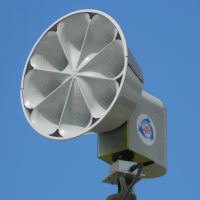 An ASC T-128, located in Gaffney, SC. Photo credit to TrainsandSirens1. | |
| Company | Alerting Communicators of America (1993-1997)
Excel Alerting Systems (1997-1998)
|
|---|---|
| Produced | 1993-present |
| Type | |
| Sound output | 113-133.5 dB @ 100 ft |
| Frequency | 50/60 Hz |
| Horsepower | 7-20 hp |
| Voltage | 48 V DC
72 V DC (T-135AC/DC) |
| Preceded by | |
| Documentation | Manual Product sheet |
The Tempest series of sirens is a series of DC high powered electromechanical sirens produced by American Signal Corporation (ASC) and is their current lineup of mechanical sirens. Making use of a modular design, these are well known for their deep, penetrating sound and reliable performance, and are a popular choice of siren across the United States and is ASC's answer to Federal's popular 2001 series.
History
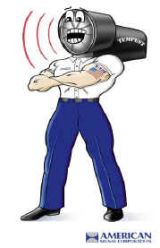
The Tempest series was formed around 1996, Dale Moeller owner of Excel Alerting System, LLC. (EAS). Moeller chose to leave the company in 1996 after disagreements with how HÖRMANN management was running the company, and formed his own company called Excel Alerting Systems, LLC. In 1996, Moeller designed and developed the Tempest-128, and several units were sold by Excel during that year.
Dale Moeller bought the struggling ASC back from HÖRMANN in 1999, and the Tempest lineup would be incorporated into ASC's product offering of the Tempest T-128, T-112 and T-121 also beginning production. These would ultimately replace ASC's OM and RM series of sirens, with the RM-135 joining the Tempest series as the P-50/T-135AC, which would later be replaced by the T-135AC/DC in 2006.
The Tempest series continues to be produced to this day and will likely continue to be sold for many years to come, as they have proven to be reliable DC powered sirens with great sound output and has firmly established ASC's foothold in the siren market after their struggles in the 1990s. These sirens can be found all across the United States. The most popular siren is the Tempest-128, with the Tempest-121 following close behind.
Design
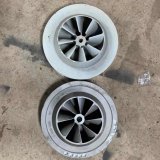
The Tempest series is modular, meaning that every model (excluding the T-135AC/DC for its rotor/stator and motor) uses the exact same rotor, stator, and motor, and are interchangeable. This simplifies the production of these sirens, allowing them to be cheaper than they otherwise would be, and ensures consistency in performance and sound. All Tempest series sirens also share the same common mounting plate footprint, making installation and future upgrades easy. Tempest sirens are made with Fiberglass shrouds and covers, which helps resist corrosion and protecting the siren's internals. All Tempest sirens run on DC power, allowing them to have battery backup capabilities, as well as optionally running on a solar panel or AC rectifier. Interestingly, the Tempest series of sirens do not use traditional intake tubes or cones. Instead, the rotor itself has an integral conical intake that draws in air efficiently without needing an external intake. The vanes are directional, with the siren running more efficiently when spinning counterclockwise. All Tempest sirens are 8-port single tone and utilize the aforementioned DC electric motors capable of running on battery backup for up to 30 minutes after mains power is lost.
Originally all Tempest series sirens were equipped with Advanced DC brand motors. All new sirens are equipped with the more durable D&D brand motors.
5 segment collector rings using standard ACA/ASC brushes/holders were standard on the T128/T135. The two top rings were used for an optional stator heating system, that was removed after any sort of benefit was negated by the increased cost of manufacturing, and dubious benefits they provided.
There are 4 models currently in production in the Tempest series:
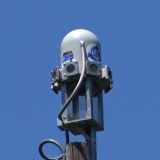
Tempest-112 (T-112)
The Tempest-112 is a small omnidirectional siren that is the cheapest and most basic of the Tempest series. It was introduced into ASC's lineup in June of 1998 when Hoerman GmbH purchase Excel Alerting Systems, LLC. along with the Tempest-121 and Tempest-128. The T-112 is essentially just a T-121 that has had its horns removed and is the core of every Tempest siren. Like the rest of the Tempest series, the T-112 is exclusively 8-port single tone, The stators on this siren have extended stator port holes, where the horns would have been mounted. Running on a 7.5 hp 48 V DC motor, the T-112 manages to reach 113 dB at 100 ft, despite the lack of horns. The motor is protected by a rounded motor cover, and the siren intakes from below, held up by a rectangular stand with a mesh screen to protect the rotor. T-112s have the shortest range of any Tempest siren and are intended for use to fill small coverage gaps or as a cheap DC warning siren for towns on a budget. It is a direct competitor to the Federal Signal ECLIPSENH, and Sentry's smaller sirens such as the 3V8-H-B.
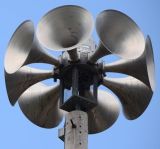
Tempest-121 (T-121)
The Tempest-121 is the best omnidirectional siren in the Tempest series, being a Tempest-112 with 8 round exponential horns attached to the extended stator ports. Like the rest of the Tempest series, the T-121 is exclusively 8-port single tone, The stators on this siren have extended stator port holes, where the horns are mounted. The T-121 runs on the same 7.5 hp 48 V DC motor as the T-112, but the horns significantly increase its volume and range and allow it to reach 121 dB at 100 ft, significantly more than the T-112. The motor is protected by a rounded motor cover, and the siren intakes from below, held up by a rectangular stand with a mesh screen to protect the rotor. The T-121 is easily the most popular of the two sirens, though it is still outsold by the T-128. The T-121 directly competes with the Federal Signal ECLIPSE8, and Sentry's larger sirens such as the 7V8-B and 14V-B. These are a popular severe weather and fire siren for smaller towns.
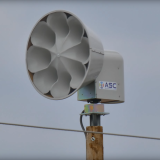
Tempest-128 (T-128)
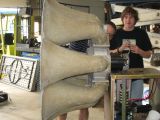
The Tempest-128 is a precision rotational siren, which is essentially a rotating directional Tempest-121. The T-128 uses an 8-port rotor driven by a 7.5 hp 48 V DC motor located in the rear housing, identical to that of the T-112. Eight large L-shaped horns are directly bolted to the stator ports, which forces the sound up and out of the front of the siren directly, which greatly increases sound output and range, and allowing the siren to boast a sound output of 129.9 dB at 100 ft. These horns converge at the very front of the siren, forming a "flower" shape. To protect the horns from corrosion or damage, a large two-piece shroud is place over the chopper and the horns, and the slits between the horns and the shroud act as the air intakes for the chopper. ASC originally outsourced the casting of the siren's projector horns to a company known as Fiberdome, however in 2021 Fiberdome found it could not keep up with demand for all of the casting, resulting in ASC creating their own second mold that they cast themselves in-house.
ASC's mold differs from the Fiberdome mold by lacking the divisions between each horn, giving it a distinctive look. Both the Fiberdome and ASC versions are currently in production. The siren is rotated through the use of an internal direct-drive rotator, using a ¼ hp motor connected to a gear reducer to drive a small gear around a larger gear. This is located directly below the motor, and this is also where the collector rings are located. The speed of the rotator is adjustable between 2-6 rpm, with T-128s installed by Fulton Services often being set to 4 rpm. The siren rotates over a very small stationary box that holds the wiring, attached to the mount. The T-128 is easily the most popular siren in the Tempest series, rivaling Federal Signal's 2001-130 and 508-128 in popularity as a severe weather or disaster siren.
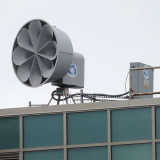
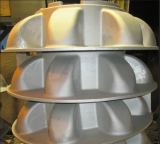
Tempest-135AC/DC (T-135AC/DC)
The Tempest-135AC/DC is the largest of the Tempest series, and is very similar to the Tempest-128. It has a significantly larger rotor (roughly the size of the Penetrator-15's rotor), an RM-130 style stator, larger horns with a more direct rear entry, enlarged projector shroud, and using a much stronger 20 hp 72 V DC motor. This allows the siren to reach 133.5 dB at 100 ft, slightly lower than the model name would indicate but still incredibly loud. The T-135AC/DC is otherwise identical to a T-128. The T-135AC/DC was introduced in 2006 to replace the aging T-135AC, which was a rebranded ACA Penetrator-50, which holds the title for loudest electromechanical rotating siren to this day but lacked battery backup capabilities and consumed 480 V AC of power.
The T-135AC/DC is louder than the T-135AC by 1dB based on testing that was done by an independent consultant for Exelon Nuclear in Illinois, while boasting battery backup, longer range, and DC power capabilities. It is currently the loudest rotating mechanical siren produced today, unless Lion King's claim about their DEFENDER and Chrysler's claim for the Bell Victory Air Raid Siren is to be believed. The T-135AC/DC is harder to find than the T-128, as the T-128 has a significantly better price/performance ratio which has led to sales of the T-128 overshadowing the T-135AC/DC. Some municipalities may also see the T-135AC/DC as overkill, and the increased maintenance required from the additional necessary batteries may turn off potential buyers. However, many T-135AC/DC units are in service today, proving them to be effective at their job.